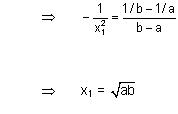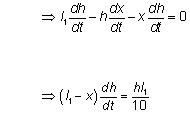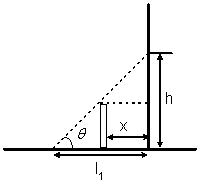Objective Type Questions
42. Total number of parallel tangents of f1(x) = x2 – x + 1 and f2(x) = x3 – x2 –2x + 1 is equal to
(A) 2 (B) 3
(C) 4 (D) None of these
Solution:
(D) f1’ (x1) = 2x1 – 1, f2’(x2) = 3x22 – 2x2 – 2 .
Let tangents drawn to the curves y = f1(x) and y = f2(x) at (x1, f(x1)) and (x2, f(x2)) are parallel, then 2x1 – 1 = 3x22 – 2x2 – 2, which is possible for infinite number of order pair (x1, x2).
43. The function 2tan3x – 3tan2x + 12tanx + 3, x Î is
(A) Increasing
(B) Decreasing
(C) Increasing in (0, p/4) and decreasing in (p/4, p/2)
(D) None of these
Solution:
(A) Let f(x) = 2 tan3x – 3tan2x + 12 tanx + 3
f'(x) = (6tan2x – 6tanx + 12) sec2x
= 6sec2x (tan2x – tanx + 2) > 0
Hence f(x) is always increasing.
44. Let f (x) = (4–x2)2/3 , then f has a
(A) a local maxima at x = 0 (B) a local maxima at x = 2
(C) a local maxima at x = –2 (D) none of these
Solution:
(A) f(x) = (4 – x2)2/3
f'(x) = –4x / 3(4–x2)1/3 = 4x / 3(x2–4)1/3
at x = –2 local minima
x = 0 local maxima
x = 2 local minima
45. Let f (x) = x3 – 6x2 + 9x + 18, then f (x) is strictly decreasing in
(A) (–∞, 1] (B) [3, ∞)
(C) (–∞, 1] U [3, ∞) (D) [1, 3]
Solution:
(D) f(x) = x3 – 6x2 + 9x + 18
f'(x) = 3x2 – 12x + 9
= 3(x2 – 4x + 3)
= 3(x – 1)(x – 3) £ 0
x ∈ [1, 3]
46. The absolute minimum value of x4 – x2 – 2x+ 5
(A) is equal to 5 (B) is equal to 3
(C) is equal to 7 (D) does not exist
Solution:
(B) f(x) = x4 – x2 – 2x + 5
f'(x) = 4x3 – 2x – 2
= (x – 1) (4x2 + 4x + 2)
Clearly at x = 1, we will set the minimum value which is 3.
47. Equation of the tangent to the curve y = e–|x| at the point where it cuts the line x=1
(A) is ey + x =2 (B) is x + y = e
(C) is ex + y = 1 (D) does not exist
Solution:
(A) y = e–|x| cut the line x = 1 at (1, 1/e)
(dy/dx)(11,1/e) = –1/e
Tangent y = –1/e = –1/e (x – 1)
=> ey + x = 2
48. Rolle’s theorem holds for the function x3 + bx2 + cx, 1 < x < 2 at the point 4/3, the value of b and c are;
(A) b = 8, c = - 5 (B) b = -5, c = 8
(C) b = 5, c = -8 (D) b = -5, c = -8.
Solution:
(D) f'(4/3) = 0
=> 16 + 8b + 3c = 0
Also f(1) = f(2)
=> 3b + c + 7 = 0
Hence b = – 5, c = –8
49. The number of value of k for which the equation x3 – 3x + k = 0 has two different roots lying in the interval (0, 1) are
(A) 3 (B) 2
(C) infinitely many (D) no value of k satisfies the requirement.
Solution:
(C) Let f(x) = x3 – 3x + k
f'(x) = 3(x – 1) (x + 1)
only are root may lie between –1 and 1
50. From mean value theorem: f(b) – f(a) = (b –a) f' (x1); a < x1 < b if f(x) = 1/x , then x1 =
(A) √ab (B) a+b/2
(C) 2ab/q+b (D) b–a/b+a
Solution:
(A) Since f(x) = 1/x
f'(x1) = f(b) – f(a) / b – a

13.1 OBJECTIVE LEVEL – 2
51. The minimum value of ax + by, where xy = r2, is (r, ab >0)
(A) 2r √ab (B) 2ab√r
(C) –2r √ab (D) None of these
Solution:
(A) Let f(x) = ax + br2 / x
f ’(x) = a – br2 / x = 0
x = √b / √a r
f (√b / √a r) = a√br / √a + √br2 / √br √a = 2r √ab
52. If a, b, c, d are four positive real numbers such that abcd =1, then minimum value of (1+ a) (1 + b) (1 + c) (1 + d) is
(A) 8 (B) 12
(C) 16 (D) 20
Solution:
(C) Applying AM ³GM

Multiplying all focus (1 + a) (1 + b)(1 + c)(1 + d) ³ 16
53. A lamp of negligible height is placed on the ground ‘l1’ metre away from a wall. A man ‘l2’ metre tall is walking at a speed of l1/10 m/sec. from the lamp to the nearest point on the wall. When he is mid-way between the lamp and the wall, the rate of change in the length of this shadow on the wall is
(A) –5l2 / 2 m/sec. (B) –2l2 / 5 m/sec.
(C) –l2 / 2 m/sec. (D) –l2 / 5 m/sec.
Solution:
(B) Clearly h / l1 = l2 / l1 – x
=> hl1 – hx = l1l2 (Since h is decreasing put a – ve sign)

at mid point x1 = l1/2, h = 2l2
=> dh/dt = 2l2/5
f ’(x) = 2ex + ae-x + 2a + 1> 0 clear a > 0
54. Let f (x) =  . If f (x) has a local minima at x = 1, then
. If f (x) has a local minima at x = 1, then
(A) a > 5 (B) a > 5
(C) a > 0 (D) none of these
Solution:
(A) f (x) = 
Local minimum value of f (x) at x = 1, will be 5
i.e. 1 –x + a ³ 5 at x = 1 => a ³ 5
55. Global minimum value of f (x) = x8 + x6 –x4 –2x3 –x2 –2x + 9 is
(A) 0 (B) 1
(C) 5 (D) 9
Solution:
(C) We will get the minimum value of f(x) at x = 1 which is 5
View courses by askIITians


Design classes One-on-One in your own way with Top IITians/Medical Professionals
Click Here Know More

Complete Self Study Package designed by Industry Leading Experts
Click Here Know More

Live 1-1 coding classes to unleash the Creator in your Child
Click Here Know More


